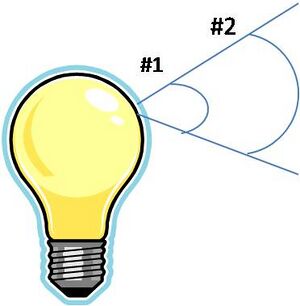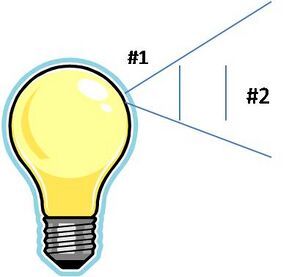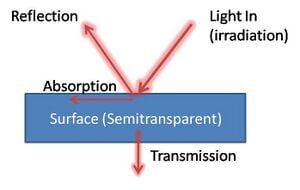Abstract
Introduction
The goal of this project is to increase the lighting intensity of a single light bulb by adding a reflective shield to the bulb that would direct the light downwards. This would hopefully improve the quality of lighting in households where a single bulb is the only light source. The quality of the light source itself will not be altered; as such an increase in lighting quality will be due solely to the added reflector. The comparison between reflective options was based solely on their increase in illumination intensity.
Measuring Light Intensity
There are three primary quantities that measure light intensity: lumen, candela and lux. The addition of a reflective covering would only increase the candela and lux of the bulb
Lumen
A lumen is a measure of light flux, the rate of energy flow from the light source to its surroundings. This quantity is independent of the light pattern (direction of the light) which means that high lumen measurements do not equate to high lighting quality [1]. Lumen can be calculated by multiplying the intensity (in candela) by the angle [2] . Table 1 outlines typical lumen values for lighting[2]
| Light Source | Lumen |
|---|---|
| 60 – Watt incandescent lamp | 890 |
| 18 – Watt compact fluorescent lamp | 1200 |
| 4 – foot long T-8 fluorescent lamp | 2850 |
Candela
A candela is a measure of light intensity. It corresponds to the amount of light emitted over an angular span. This span is measured in steradian; this measure has no unit and quantifies three dimensional angles. 4π steradian is one sphere. An interesting aspect of this measure is that the candela of a light source is independent of how far away it is measured, since angle is not affected by horizontal distance.[3] Figure 1 demonstrates the effect of distance on candela, the candela measured at points 1 and 2 is the same.

Lux
Illumination intensity (add Wikipedia link) is measured in lux. Lux is a unit corresponding to the light density on a surface; one lumen per square meter[1]. This unit is very similar to a candela with the only difference being it measures the intensity over a surface instead of an angle. Figure 2 depicts the relationship between illumination intensity and distance, the lux measurement at location 1 would be greater than that of location 2.

Material Properties
When light hits the surface of a material it has three options; it can be reflected, absorbed or transmitted as illustrated in figure 3 [4]. In order for transmission to occur the surface must be semitransparent. This behaviour plays a large role in everyday life, reflectivity and absorption are the primary contributors to colour. The colour of an object is dependent on which wavelengths of light are being reflected and absorbed on its surface. Different combinations of reflection and absorption result in different colours.

For the purpose of this project reflection is the most important aspect since light intensity of the bulb will increase in proportion to the reflective properties of the reflector. There are two different types of reflection, spectral and diffuse. Figure 4 illustrates the difference between these two types of reflection. Diffuse reflection occurs on rough surfaces, when a beam of light hits a rough surface it is broken up and reflected in many different directions.

Lighting Quality
References
- ↑ 1.0 1.1 Wulfinghoff, D.R (1999). "Energy Efficiency Manual", Energy Institute Press
- ↑ 2.0 2.1 Benya, J.R. Karlen, M (2004). "Lighting Design Basics", John Wiley & Sons
- ↑ "Candela, Lumen, Lux: the equations", CompuPhase, http://www.compuphase.com/electronics/candela_lumen.htm
- ↑ Incropera, DeWitt, Bergman, Lavine. "Fundamentals of Heat and Mass Transfer". John Wiley & Sons